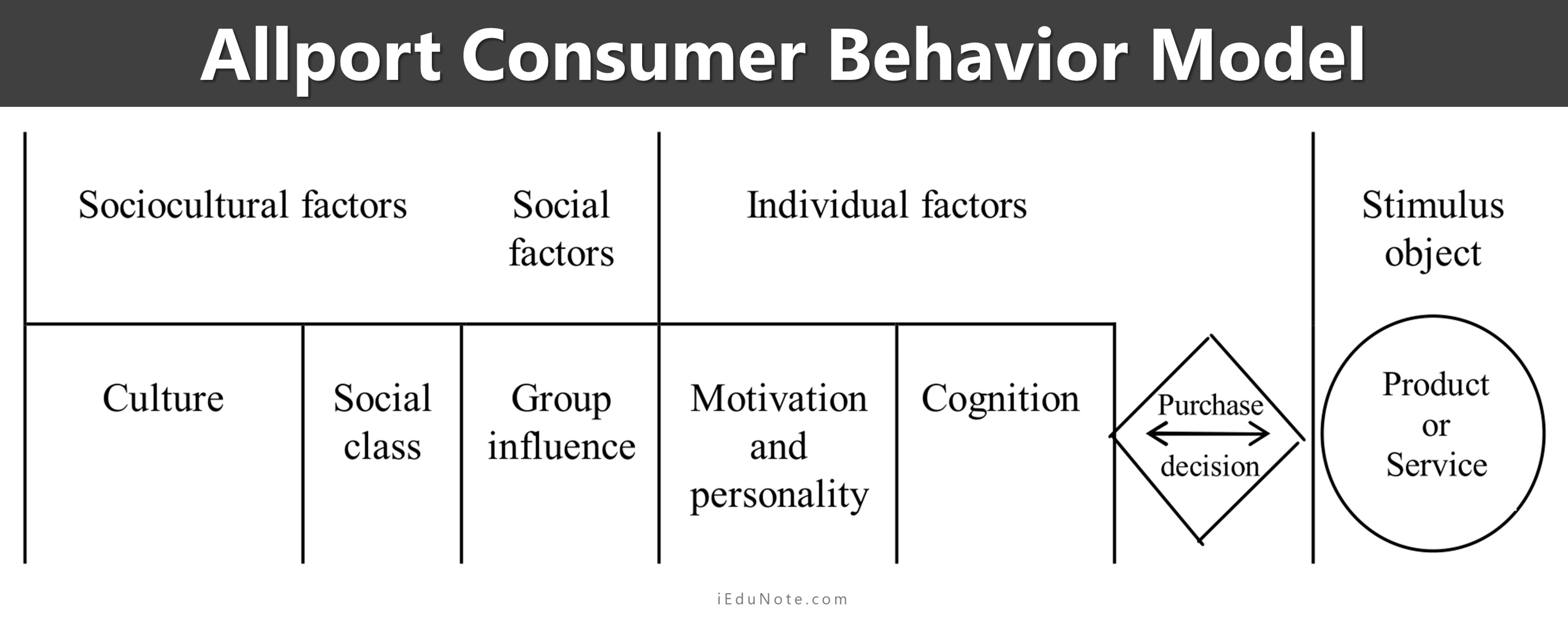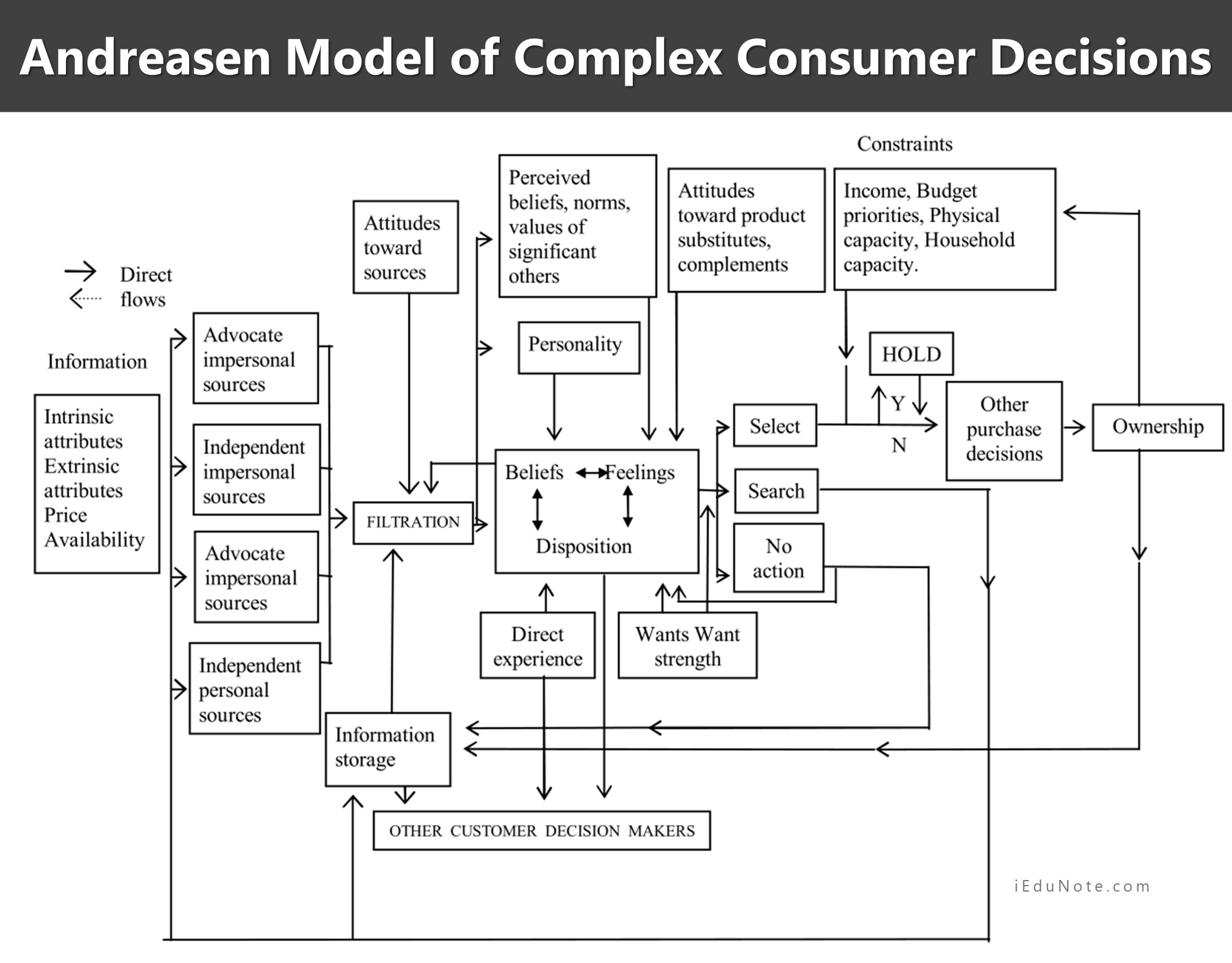Allport consumer behavior model basically shows the relationship of socio-cultural, social, and individual factors with that of the stimulus objects relating to products or services.
An individual’s consumption or purchase decision is the outcome of this interaction. The stimulus objects relating to the product or service continuously interact with these three sets of factors. The result of the interaction is the decision of the buyer.
If the result of the interaction is positive, the buyer will decide to buy the brand, and if the result is negative, he will forego the idea of buying the brand whose stimuli he considered.
Let’s describe this model’s elements briefly because you will have separate units to study covering each of the factors in detail.

Socio-Cultural Factors and Their Influences on Buying
What products you buy, the way you use them, the frequency with which you buy and use them, and even the methods you apply to buy them all are determined by the cultural context of which you are apart.
For example, males’ putting on earrings is not approved by Indian culture, but it is not discouraged in Western culture. That is why many males in western countries use earrings, where males of India do not use earrings because Indian culture does not permit it.
Regarding the buying method, self-service is preferred by people of certain cultures, wherein Indian culture is not still a common practice. Bargaining is preferred here in Indian culture, where it is not a practice in other cultures.
In India, we test the freshness of fish by pressing it through fingers, where it cannot be imagined in modern developed culture.
Marketing now days no more considered a local or national phenomenon, rather a multinational phenomenon. The products that you produce here in India may have markets well beyond the Indian national boundary.
Therefore, to be successful, marketers should have ideas on other cultures and their own if they plan to market their products elsewhere.
Cultural traits are not the same everywhere. There is great diversity found among cultures. Certain cultures are characterized by value shifts and technological change (such as western cultures), where others are characterized by insularity and tradition (such as India culture).
These differences affect the products and services people buy. Because of relaxed sexual mores, certain products have perfect markets in western cultures (such as mini-skirts), and even certain products may be advertised through public media.
Where in a traditional culture, these products cannot be sold and advertised publicly. The values retained by cultures are not rigid; rather, they change over time. Even in India’s country, values have changed significantly over the last couple of decades, bringing substantial consumption behavior changes.
Use and purchase/consumption of certain products and services such as fresh flowers, mineral water, tissues (hand, toilet, facial), mobile phones, debit and credit cards, prepackaged/instant food items, e-mail, internet service, cable television are a few of the examples of such changes taken place even in culture.
There are often subcultures within a culture, adding to the complexity of cultural influence on consumer behavior. Just as there are unique market segments within a more generally defined market, there are also diversities within a culture.
Undoubtedly, differences exist based on region, religion, age, income, family structures, etc. Indians worldwide like fish, but people of certain areas of the country like dry fish. This is an influence of subculture.
For example, urban people eat bread at breakfast, where rural people eat rice at their breakfasts. The upper class in the city areas like to eat out frequently due to which restaurant and fast food shops have established heavily in these areas.
Social Factors and Their Influences on Purchase/Consumption Decision
Human beings work and live with each other and are generally influenced by some of them. In particular, consumers are affected by their social class, reference group, and family. The influences of these social factors are just as pervasive as cultural factors.
People belonging to a particular social class tend to have similar beliefs, lifestyles, and buying patterns. They purchase similar products from the same stores and live in the same types of neighborhoods and houses.
People conform to patterns of living and buying accepted by the other members. Although lifestyles are quite similar within a social class, they vary considerably from class to class.
Consumers can belong to a variety of reference groups. A reference group is a group of people with whom the individual looks for the association, information, and behavior standards. These groups can be formed on many bases, including family, work, professional, religion, civic, educational, and recreational.
These groups exert a tremendous and widespread impact on consumer buying behavior. Reference groups can influence both the type of product purchased and the brand name selected.
The family usually is the most significant group for the consumer, exerting a stronger and more wide-ranging influence on lifestyles and purchasing behavior than any other. Decision-making in the family and the influence of a particular member in such a decision depends on the product or service in question.
Certain decisions are made individually by a particular member, while others are taken collectively. It varies according to the type of the product and the life cycle stage where the family fits. Newly married couples are found to take most of the decisions jointly. Patterns of consumption also change over the family life cycle.
Singles, for example, will require different types of products than the newly married couples, and families with a newborn child will require certain types of products not required by the families having older children.
You will note that number of changes are taking place in the social structures having profound impacts on purchase/consumption decisions. The emancipation of women in urban India, for example, has created a new breed of customers free to decide what they want.
As more mothers involve in professions, the markets for disposable diapers, baby food, daycare centers are emerging here in urban India. As more women become careerists, they feel reluctant to breastfeed their babies to keep their figures fit, save time, and avoid hassles creating a solid market for baby food.
Individual Factors and Their Influences on Buying/Consumption Decision
The individual consumer variables are equally important as the cultural and social forces on purchase/consumption decisions. Every individual is a unique entity though he is a part of the culture and different social groups. Thus, the number of individual consumer variables come into action while the person contemplates a purchase decision.
Consumer decisions are influenced by his previous experiences that determine his learning. If you were dissatisfied with a particular brand, this experience would definitely shape your future decisions.
In fact, aside from the instinctive needs, all needs are learned from past experiences and other individuals or groups and the manners in which they seek to satisfy them. The learning theories suggest that marketers should increase their stimuli’ intensity, including advertisements for learning to occur quickly.
Although consumers have many needs that are basically similar, they try to satisfy them in quite different ways, depending on how they perceive both their needs and the environment in which they operate.
In fact, two people with identical needs may take different actions to fulfill them based on their perceptions of the situation.
Since people perceive differently and selectively, stimuli that marketers give to markets should be different for different groups. The selectivity of perception suggests that marketers’ advertisements and other stimuli should be outstanding for ensuring their target markets’ perception.
At the center of a consumer’s buying decision is their physiological and psychological/social motives. A motive is a force, which has been activated into a state of tension, causing the individual to seek to satisfy a specific need since motives vary from person to person, so their behaviors vary.
Some are motivated by price where others are by quality, still others by features of the product and a wide range of other factors. If marketers conduct motivation research, it may reveal hidden consumers’ motives, and the findings may be utilized to devise marketing strategies.
The personality of consumers is another individual factor that determines behavior. Each consumer is unique in terms of their ambitiousness, conservatism/liberalism, degree of extroversion, etc. Collectively, these primary character traits comprise individual personality.
Personality pattern determines the type of product an individual will select and the style he will prefer. Why some people buy sports cars, and why do others not even if they can afford it? The simple answer is the differences in their personalities.
Marketing executives, without question, must be concerned with consumer attitudes.
They are enduring favorable or unfavorable evaluations, emotional feelings, and action tendencies toward some object or idea. If attitudes toward the firm’s goods are favorable, information about the particular product or service is more likely to be received and positively impacted consumers.
If, for example, you like a particular singer’s style (having a positive attitude toward him/her), you are likely to buy any new album released by that singer. If the attitudes are negative, that will also affect your decision, and it is challenging to change the attitude from a negative to a positive one.
In each buying decision, a consumer considers a unique set of social, cultural, and individual factors.
They remain active throughout and interact with that of the marketer dominated activities through which marketers try to influence people to buy their products. The purchase decisions are, thus, affected by this interaction as well as media and interpersonal communications.

